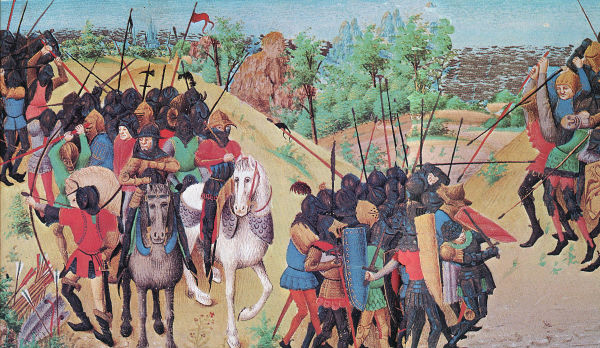Swords and Weapons from the War of the Roses
In honor of the 549th anniversary of the 1471 Battle of Barnet on April 14th, 2020, we present "Swords and Weapons from the War of the Roses"! Sure, it's a random anniversary, but we will take any opportunity look at this exciting period of history. The War of the Roses was a dynastic conflict in 15th century England that pitted the Plantagenet houses of Lancaster and York against each other. Essentially, it was a struggle between two sets of descendants of King Edward III who, between 1455 and 1487 set about deposing and killing each other, raising armies, rebelling, and fighting a series of famous battles including those of
Towton (1461),
Tewksbury (1471), and
Bosworth Field (1485).

For a recent and rather dramatic documentary take on this period check out this free video,
"The Complete Collapse of King Henry VI". While the armors and some of the weapons in this video are pretty ahistorical (those breastplates and helms are ridiculous), it gives a decent rundown of the conflicts of the War of the Roses. You can compare the armors in the documentary to that from a period English funereal effigy from 1484 below.
This period of the mid-15th century was in many ways the epitome of late medieval warfare with hundreds of knights in full plate armor fighting it out mounted and on foot. Armor was highly developed, and so the weapons for fighting in armor had also become highly specialized.

This is the period when longswords had really emerged as the favored sword of the knightly class, to some extent supplanting the earlier one-handed knightly swords that were popular from the Viking period through the early 14th century. These swords typically had a grip long enough for two hands, but with a dynamic balance that also allows use in a single hand, which was especially useful when mounted and after breaking or losing one's lance. Our
Towton Longsword is an excellent example of a warriors sword from the period, so much so that we named it after the Battle of Towton. This sword has a rigid diamond cross section suitable for fighting an armored foe and weighs about 3.3lbs. It has a balance point of about 3.4 inches below the cross, allowing it to move quickly, but with authority.

Our English Longsword, Bohemian Broadsword, and French Medieval Sword also all date from the period of the War of the Roses and are of types certainly used in the conflict. The English Longsword and Bohemian Broadsword both feature thinner and slightly more flexible blades typical of a knightly sidearm that was particularly suited to to fighting the less heavily armored foot soldiers that made up the bulk of the forces in some of these battles. While many swords had been rendered less effective against knightly foes due to the quality of 15th century plate armor, they were still an important weapon, especially since most combatants did not necessarily have state of the art armor.

The 15th century also saw the emergence of other types of arms that were optimized for fighting heavily armored men. These weapons, such as pole hammers, axes, and maces, were able to concentrate a great deal of force in a small area, thereby damaging armor and injuring the fighting man inside. These impact weapons were meant to be wielded largely by fully armored combatants, as opposed to the longer polearms such as halberds and bills that were usually used by less armored foot soldiers. Poleaxes such as our
Bec de Corbyn,
Knightly Poleaxe, and
Burgundian Poleaxe are just such weapons, and as most of our products, are direct replicas of extant weapons from the period. These weapons were all also meant to be used in two hands, on foot. This meant that no shield could be used, which was OK, because the armor was supposed to protect you.

There were also period impact weapons that were held in one hand, which could be used with a shield, and also wielded while mounted. These included items like our
War Hammer and
High Gothic Mace.
As you can see, the War of the Roses featured some of the most iconic swords and weapons of the medieval period, and a lot of high drama between competing royal families. It is also a period that has inspired dramatic depictions and epic drama, from contemporary dynastic fantasies such as Game of Thrones, to classics like
Shakespeare's Henry VI. So, grab a sword and declare yourself for York or Lancaster!
Nathan Clough, Ph.D. is Vice President of Arms and Armor and a member of the governing board of The Oakeshott Institute. He is a historical martial artist and a former university professor of cultural geography. He has given presentations on historical arms at events including Longpoint and Combatcon, and presented scholarly papers at, among others, The International Congress on Medieval Studies.
Craig Johnson is the Production Manager of Arms and Armor and Secretary of The Oakeshott Institute. He has taught and published on the history of arms, armor and western martial arts for over 30 years. He has lectured at several schools and Universities, WMAW, HEMAC, 4W, and ICMS at Kalamazoo. His experiences include iron smelting, jousting, theatrical combat instruction and choreography, historical research, European martial arts and crafting weapons and armor since 1985.














